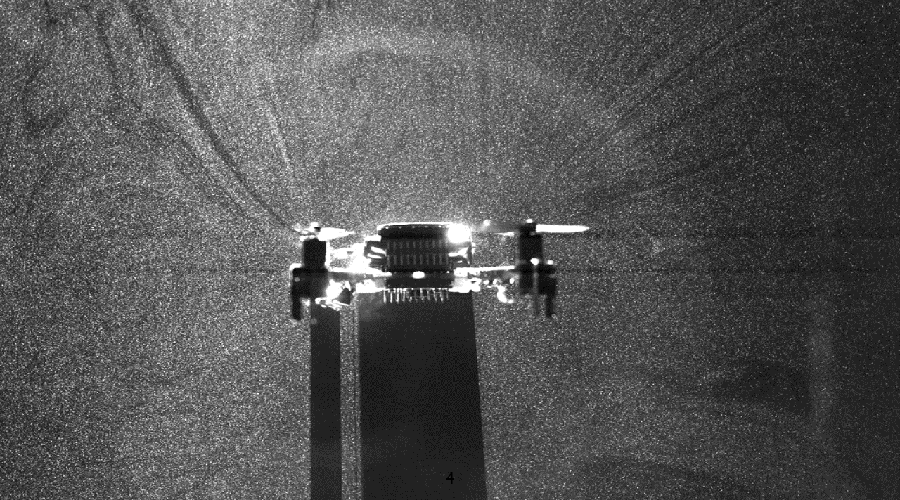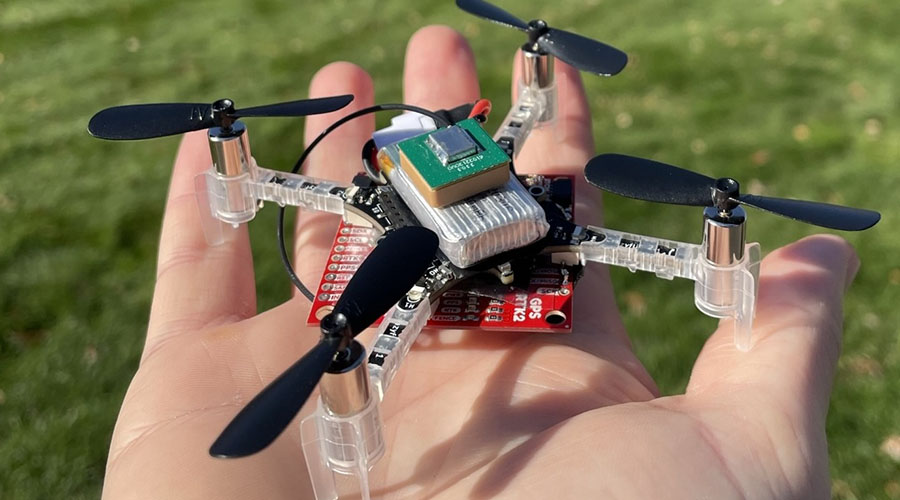At an APS fluid dynamics meeting, researchers showed off new robotic technologies for studying atmospheric pollution.
By Sophia Chen | January 11, 2024

Credit: Girguis Sedky
“LaDrone,” a micro aerial vehicle designed by a Princeton team, hovering in a laser-illuminated particle field.
It can be a tough act, delivering a talk at the end of the day at a conference. But Nate Simon brought a tiny drone to entertain the audience. Resembling a flying crab and about the weight of a plum, the robot rose into the air and meandered across the room before Simon, a fourth-year robotics graduate student at Princeton University, let it plummet to the ground. The audience laughed.
In recent years, researchers like Simon have begun developing drones to study matter in the atmosphere. “People are interested in understanding the flow,” says Simon, who presented his work in Washington, DC, at this November’s annual meeting of APS’s Division of Fluid Dynamics. “That could be to track pollutants, how wildfire smoke disperses, or understanding how mosquitoes fly and find humans.”

Credit: Nate Simon
LaDrone consists of a GNSS antenna, receiver, and datalogger built on a Crazyflie drone.
Visualizing and measuring fluid flow isn’t new: Aerospace engineers have long done so by blowing smoke into wind tunnels. But these are idealized environments. The challenge is making the same measurements in chaotic real-world environments, says Jiarong Hong of the University of Minnesota, who also presented at the conference. “In a wind tunnel, you know the wind speed,” says Hong. “But in field experiments, there are a lot of factors you can’t control. The wind changes. There are gusts.”
Hong’s team has developed a fleet of four drones that use a sensor that acts like a 3D microscope, along with computer vision, a type of artificial intelligence, to track the flow of wildfire smoke. After testing the drones’ ability to detect smoke in a computer simulation, Hong’s team began field experiments. They flew the drones through smoke generated from a smoke machine and smoke grenade.
The drones coordinate with each other to capture microscopic images of particles, from which Hong can derive the smoke particle size, shape, and concentration. These properties influence the amount of time a particle stays adrift or its likelihood of undergoing certain chemical reactions, Hong says. This data can inform large-scale climate and atmospheric models.
It’s challenging to track smoke because it moves on the scale of kilometers, but researchers also need to make measurements on the scale of the individual particle, which are microns in size. “You need to understand how the small particles change in composition as they move in the atmosphere, and at the same time, you need to track those particles,” says Hong.
Simon’s team opted for a more minimalist approach. Other than producing a force to counteract gravity, their drone “just passively goes wherever the wind takes it,” he says. The aim is to have the drone drift with the wind and track the motion of individual atmospheric particles. Simon presented this drone as an alternative to balloons used to track wind. Engineers have tended to make balloons bigger in order to outfit them with necessary instruments, but the size prevents them from tracking individual particles.
While the drone drifts with the wind, it still has the movement capabilities of a conventional drone. Researchers can operate the drone in passive or active mode to study different atmospheric phenomena. “Maybe being completely passive is not the most efficient way to gain as much information as possible about the flow,” says Simon. “Maybe you want to kind of jump between particle streamlines.”
Credit: Girguis Sedky
The LaDrone in a laser-illuminated particle field.
One challenge was building the system that tracks the drone’s location to within a centimeter, which is necessary for atmospheric science studies. Conventional GPS technology could only pinpoint its location to about 2.5 meters, says Simon. But he applied a data processing trick to improve the GPS’s precision. By collecting location data from the drone and a stationary laptop on the ground, he could reduce the drone’s position error.
Simon’s team plans to continue testing the drone in real-world conditions. They also want to improve the drone’s design. In its current form, the drone is sensitive to weight changes. “If you added a gram or two, it wouldn't take off,” he says. So instead of using off-the-shelf components, they want to construct parts of the drone, like its printed circuit board, to be more weight-efficient.
Hong, meanwhile, plans to fly the drones through a prescribed burn at Cedar Creek in Minnesota, where controlled burns have been conducted since the 1960s. He also wants to explore the best way to coordinate as many as eight drones in his fleet. Currently, they follow a hierarchical command, where one drone overseeing the scene controls the others. Researchers are still investigating how to optimize drone coordination, he says. The research ultimately aims to track particles over kilometers, measurements that could inform environmental researchers or public health departments.
Sophia Chen is a writer based in Columbus, Ohio.
©1995 - 2024, AMERICAN PHYSICAL SOCIETY
APS encourages the redistribution of the materials included in this newspaper provided that attribution to the source is noted and the materials are not truncated or changed.
Editor: Taryn MacKinney
February 2024 (Volume 33, Number 1)
Articles in this Issue

